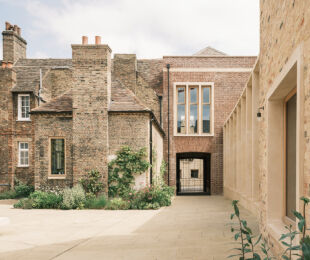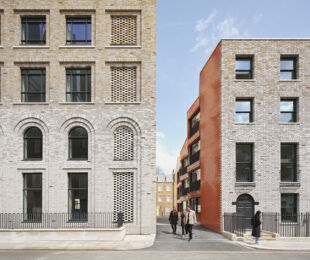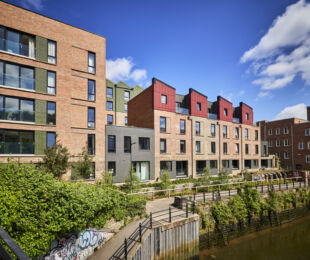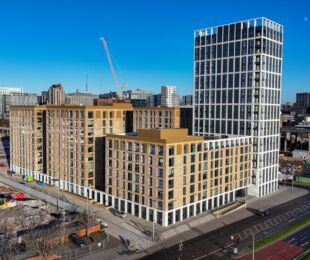
Surman Weston has completed its first self-build project, Peckham House, in south London.The new house, monolithic in its form and veiled in a distinctive hit and miss brickwork, is delicate and crafted, referencing and playfully subverting the motifs in Peckham’s vibrant and eclectic urban neighbourhood. Spanning five years, it is the practice’s first self-initiated project working as client, architect and contractor, affording freedoms and broadening experience beyond the parameters of a traditional architectural project; allowing the directors Tom Surman and Percy Weston the opportunity to set the brief, manage the budget and control the build, honing and improving the design during the construction phase. Stepping into the role of the contractor has rebooted a passion for making, which has always been a principal driver of the RIBA StephenLawrence Prize winning practice.
Tom Surman:
"The brickwork defines the exterior of our Peckham House and the delicate and crafted masonry helps to soften the blocky form of the house. As you ascend the facade, the header bricks of the Flemish bond brickwork are gradually set back further and further, creating a gradient of shadow. As such, the mass of the building seemingly breaks down the higher you, by roof terrace level the header bricks are completely removed and the brickwork appears to dissolve into the sky.
We wanted a brick that had lots of character and the right mix of colours to complement the surrounding buildings, Galtres by York Handmade was the perfect fit."
Following a two-year search which began in 2016, the council-owned site, a small patch of scrubby grass in Peckham, was purchased at auction. Located at the end of a short two-storey terrace built in the 70s, facing Victorian terraced housing of Moncrieff Street, and a stone’s throw from Peckham Levels, a brutalist multi-storey car park (now a creative workspace and a defining feature of central Peckham), Surman Weston saw great potential in the site but bought it without the assurance that it could be developed.The challenge was to reconcile the conditions of the constrained, exposed urban plot to create a generous and contemporary family home. There followed a lengthy process of design development, testing a multitude of options in close consultation with SouthwarkCouncil, before obtaining planning permission.In plan the new house aligns with the existing terrace, creating a generous front and more compact rear garden space, however, its form is a clear departure from the established double-pitched roofline. The house takes the form of a monolithic cuboid with a flat roof, bookending the corner, with the parapet aligned with the adjacent ridgeline of the pitched roof terrace.
The house is designed with a brick façade referencing the load-bearing handmade stock bricks of the Victorian terrace and the machined brick infill panels of the car park. Bricks are arranged in a hit and miss system to attenuate what would otherwise appear as a monolithic form. As you ascend the house, the header bricks in the Flemish bond brickwork are gradually set back further and further, forming a gradient of shadow. Greater gaps at the roof terrace level reveal multi-stem birch trees and twining climbing plants, a glimpse of the oasis at the top of the ascent. The uniformity of the exterior is softened with self-supporting arched openings to the front and rear, a nod to the nearby railway line and the arched detailing on the former car park. This is inverted in the entrance gate, creating a playful geometric arrangement in the street elevation.
Many of the materials are recycled and there has been a consciousness to limit material waste; from the block work walls which are made from recycled construction waste, to the end grain wood block floor, which is assembled from the waste off-cuts of the exposed ceiling joists, to the brick off-cuts which were recycled as pavers in the garden.Design choices have been guided by a steadfast ambition to reduce embodied carbon and operational energy. Materials have been sourced locally from the UK. The house is super-insulated with triple glazing and an airtight envelope with mechanical ventilation heat recovery (MVHR), with onsite energy generation in the form of photovoltaics paired with anair source heat pump. Performance data collected to date exceeds LETI’s ambitious targets for energy use and is 80% better than Building Regulation requirements.
The story of the build and the properties of the materials add texture to the house, giving it character and instilling a sense of homeliness.The roof terrace is entered through a greenhouse via a hatch clad in insulating
Percy Weston said: "Freed from the constraints of a commissioning client we felt an immense pressure to design something extraordinary, unique, innovative, but also not unfeasibly expensive! We approached the design with the concept of creating a house that could reconcile and encompass the multiple architectural styles surrounding the site – from the Victorian terraces adjacent to the Brutalist car park opposite - as well as referencing building types further afield – like Moroccan riads – creating a place in the heart ofPeckham that can provide sanctuary from the intensity of the city."Tom Surman said: “Because this was a self-build project, we could be inventive, imaginative and resourceful and respond to the context and quirks of the project as they unfolded. We changed our minds plenty of times throughout the build and we think the house got better each time we did. It became more handcrafted and as a result the house has a richness of character, detail and texture. It is an expression of our interests and personalities and is the antithesis of so many bland new-builds.”







